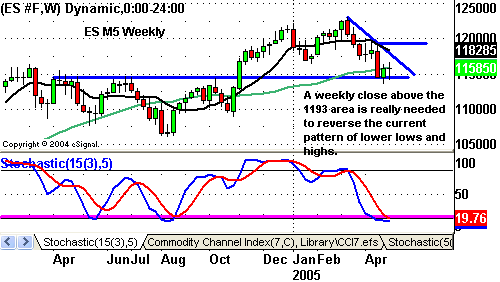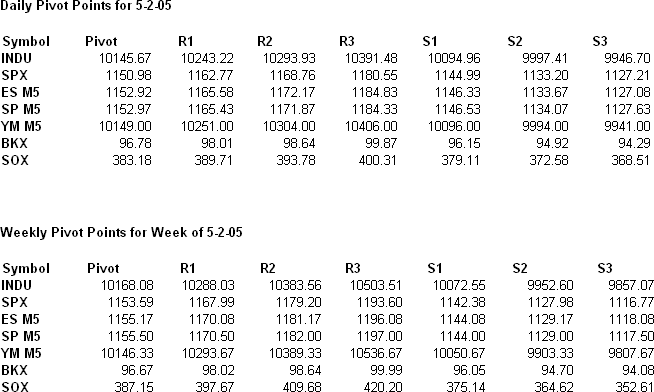Will This Be The Most Citical Event Of 2005?
The major indexes finished mixed in what was quite a
volatile week of trading. Everyday saw a different result from the
prior session, as there was a clear lack of conviction among market players.Â
This lack of conviction largely stemmed from uncertainty over what the Fed may
do next week. In addition, while earnings were decent from many companies,
guidance was less than reassuring. Compounding this uncertainty was the
economic data, which showed conflicting signs. Housing numbers continue to show
strength, while Durable Orders have started to soften. Healthcare names
outperformed again, which should come as no surprise, given the sector’s ability
to grow in just about any type of economy. On the other side of the fence, Tech
and Industrial metals shares were the worst performers, as these late cycle
plays likely have already seen sunnier days.
The June
SP 500 futures closed out the week with a small gain of +1.25 points, while the
Dow futures tacked on a gain of +9 points, with both posting gains for the 2nd
week in a row. On a weekly basis, the ES posted a dragonfly doji right at its
40-week MA. Looking at the daily chart, the contract is back up to test its
200-day MA and also daily downtrend line resistance. The YM also posted a
dragonfly doji for the week, after an inside reversal back above its 10-day MA
and into its daily downtrend line on Friday. For you daily 3-Line Break
followers, the ES remains short with a Break Price of 1174.25, while the YM is
long with a break price of 10020. Â

In the
week ahead, all eyes will be on the FOMC meeting. This could end up being the
most critical event of 2005. While Greenspan and Co. doesn’t want to spook the
equity markets, they have expressed their concerns over inflation many times
recently. The general concern is that the Fed appears to be in the process of
raising rates into an economy that is slowing. Inflation is being cited as the
reason for why rates are still being raised, however, most forward-looking
gauges of inflation are suggesting declining pricing pressures. Consequently,
many market players have started to question the Fed’s motives for continuing to
maintain such a hawkish posture.
The
most-cited reason for the Fed’s stance is Real Estate, which has been
appreciating at an unsustainable pace. The advance in Real Estate has partially
been fueled by “creative financing,†which is a major concern of things to
come. Another reason why many believe the Fed will continue to raise rates is
the fact that the Fed Funds Rate remains well below its historical norm. Over
the last 100 years, short-term rates have averaged more than 100 basis points
above the rate of inflation. At the moment, short-term rates are below the
level of inflation (as measured by the CPI). Therefore, many economists feel
that continuing to raise rates from current levels is the prudent thing to do.
There is no
question that slowing the rate of appreciation in Real Estate and getting
short-term rates back to historical norms are important goals. However, if
Greenspan overdoes things, as he did in 2000, the Fed risks putting the economy
back into recession. This time around, the economy is much more leveraged than
ever before, so the fallout from a tighter credit-based economy could be pretty
darn ugly. This suggests the Fed is currently walking a tight rope. Thus far,
the Fed has done the right thing, however, it appears that their hard work is
now in front of them. From what I can see, more than likely, is that market
players are hoping that the Fed will hint on Tuesday that they are finished
raising rates for awhile. Anything other than that may not be well-received by
the equity markets. Â
 
Please feel free to email me with any questions
you might have, and have a great trading week!
Â
Â
Â
Â
